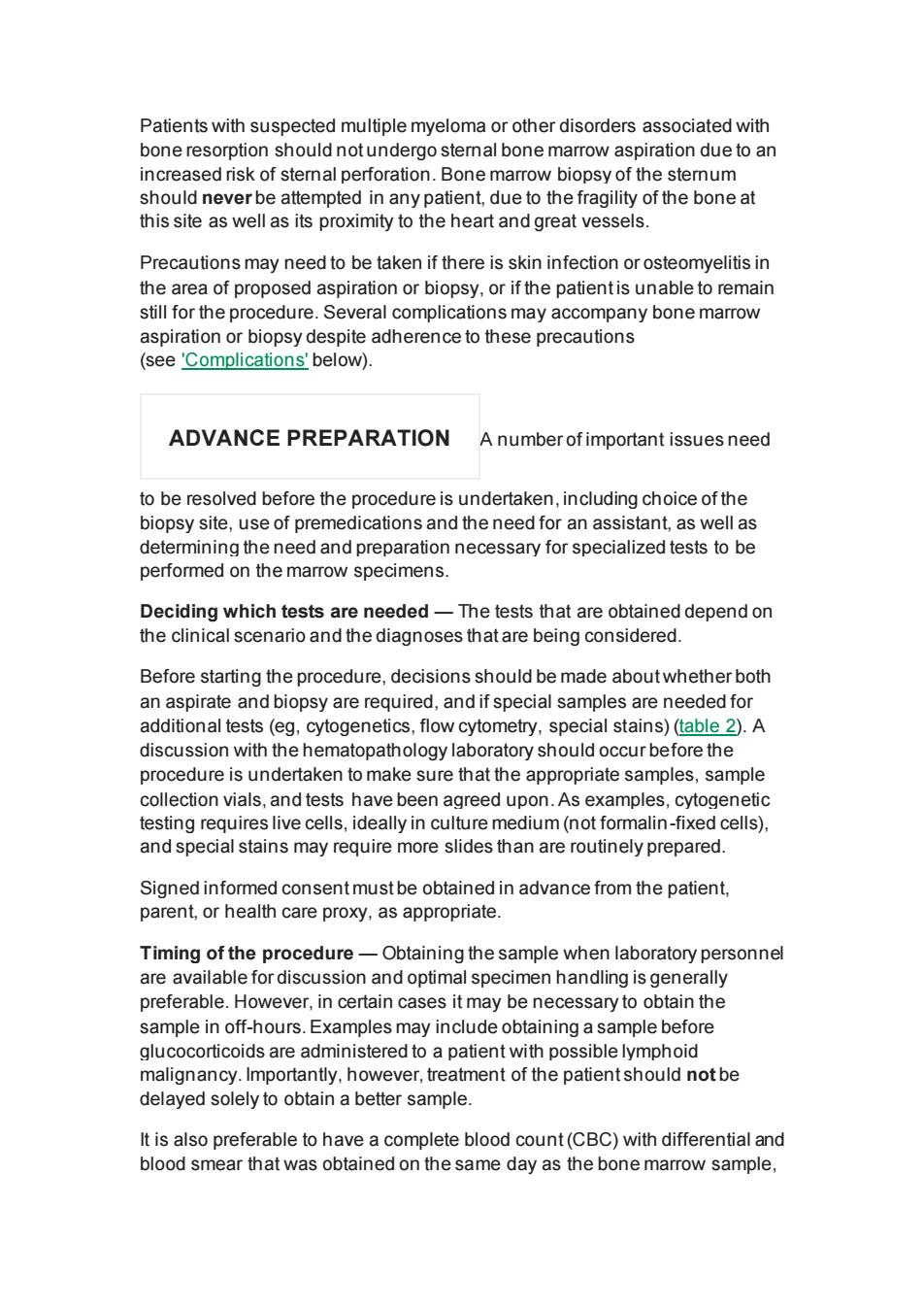正在加载图片...

Patients with suspected multiple myeloma or other disorders associated with bone resorption should not unde 90 mal bone marrow ration due to ar ncre ased of st temnal per foration.Bone marrow biopsy of the sternum should never be attempted in any patient,due to the fragility of the bone at this site as well as its proximity to the heart and great vessels Precautions may need to be taken if there is skin infection oroste omyelitis in the area of proposed aspiration or biopsy,or if the patient is unable to remain still for the procedure.Several complications may accompany bone marrow aspiration or biopsy despite adherence to these precautions (see 'Comp s'below). ADVANCE PREPARATION A number of important issues need to be resolved before the procedure is undertaken,including choice of the biopsy site,use of premedications and the need for an assistant,as well as determining the need and preparation necessary for specialized tests to be performed on the marrow specimens. Deciding which tests are needed-The tests that are obtained depend on the clinical scenario and the diagnoses that are being considered. Before starting the procedure,decisions should be made about whether both an aspirate and biopsy are required.and if special samples are needed for additional tests(eg.cytogenetics,flow cytometry,special stains)(table 2).A discussion with the hematopath logy labo atory should ccur before the procedure is undertaken to make sure that the appropriate samples,sample collection vials,and tests have been agreed upon.As examples,cytogenetic testing requires live cells,ideally in culture medium(not formalin-fixed cells). and special stains may require more slides than are routinely prepared. Signed informed consent must be obtained in advance from the patient, parent.or health care proxy.as appropriate. Timing of the procedure-Obtaining the sample when laboratory personnel are available for discussion and optimal specimen handling is generally preferable.However.in certain cases it may be necessary to obtain the sample in off-hours.Examples may include mple before glucocorticoids are administered to a patient with possible lymphoid malignancy.Importantly,however,treatment of the patient should not be delayed solely to obtain a better sample. It is also preferable to have a complete blood count(CBC)with differential and blood smear that was obtained on the same day as the bone marrow sample, Patients with suspected multiple myeloma or other disorders associated with bone resorption should not undergo sternal bone marrow aspiration due to an increased risk of sternal perforation. Bone marrow biopsy of the sternum should never be attempted in any patient, due to the fragility of the bone at this site as well as its proximity to the heart and great vessels. Precautions may need to be taken if there is skin infection or osteomyelitis in the area of proposed aspiration or biopsy, or if the patient is unable to remain still for the procedure. Several complications may accompany bone marrow aspiration or biopsy despite adherence to these precautions (see 'Complications' below). ADVANCE PREPARATION A number of important issues need to be resolved before the procedure is undertaken, including choice of the biopsy site, use of premedications and the need for an assistant, as well as determining the need and preparation necessary for specialized tests to be performed on the marrow specimens. Deciding which tests are needed — The tests that are obtained depend on the clinical scenario and the diagnoses that are being considered. Before starting the procedure, decisions should be made about whether both an aspirate and biopsy are required, and if special samples are needed for additional tests (eg, cytogenetics, flow cytometry, special stains) (table 2). A discussion with the hematopathology laboratory should occur before the procedure is undertaken to make sure that the appropriate samples, sample collection vials, and tests have been agreed upon. As examples, cytogenetic testing requires live cells, ideally in culture medium (not formalin-fixed cells), and special stains may require more slides than are routinely prepared. Signed informed consent must be obtained in advance from the patient, parent, or health care proxy, as appropriate. Timing of the procedure — Obtaining the sample when laboratory personnel are available for discussion and optimal specimen handling is generally preferable. However, in certain cases it may be necessary to obtain the sample in off-hours. Examples may include obtaining a sample before glucocorticoids are administered to a patient with possible lymphoid malignancy. Importantly, however, treatment of the patient should not be delayed solely to obtain a better sample. It is also preferable to have a complete blood count (CBC) with differential and blood smear that was obtained on the same day as the bone marrow sample